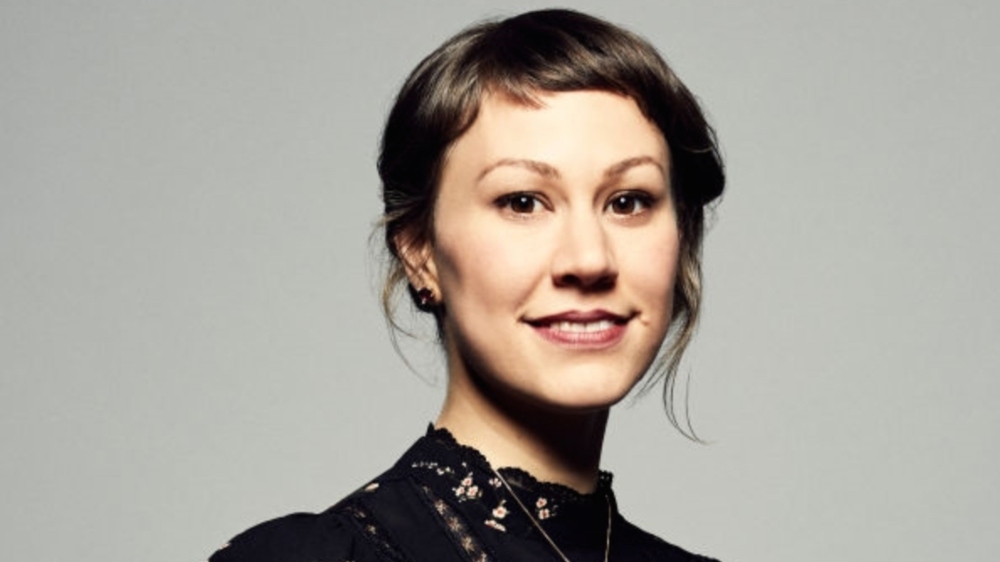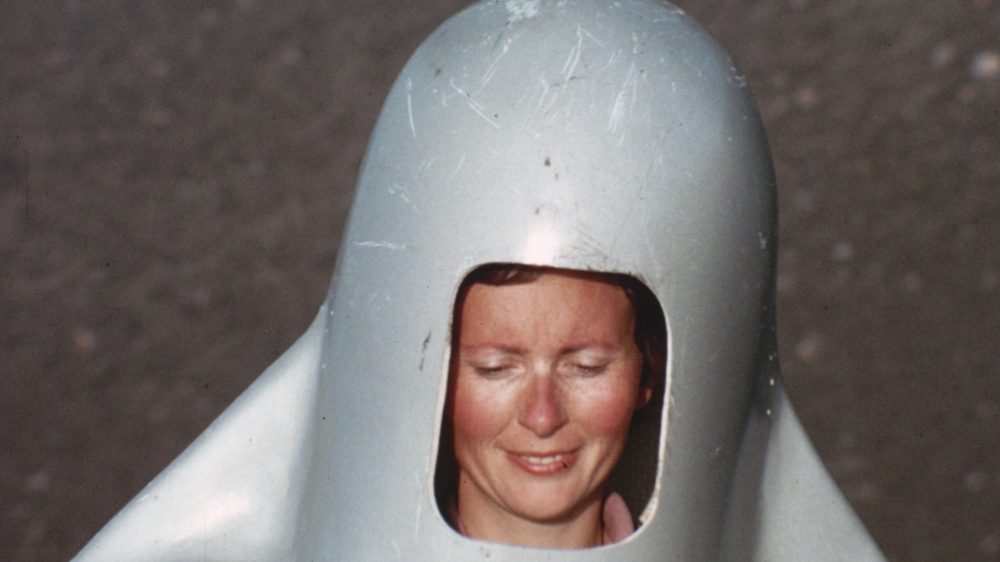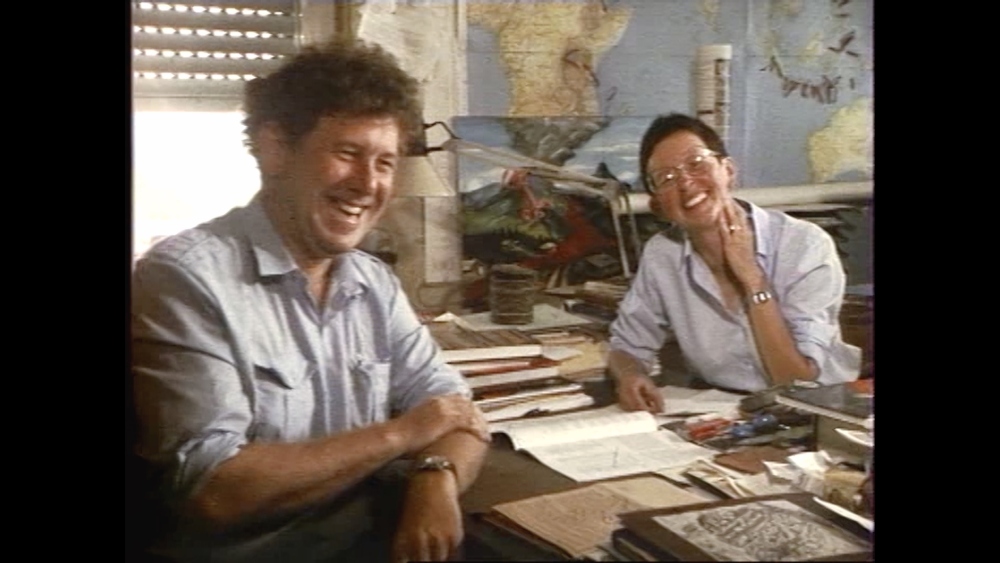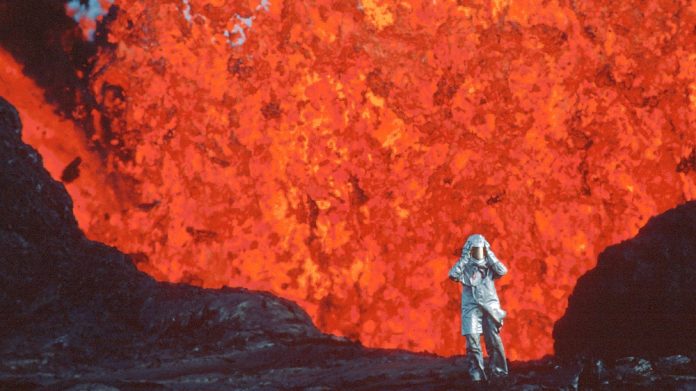Fire of Love stars Katia and Maurice Kraftt died doing what they loved, and, fittingly, they perished together. From 1970 to 1991, the married French volcanologists traversed the world studying volcanos together in an attempt to understand how they formed and how/why/when they’d roar back to life — often with fiery, cataclysmic results.
The Kraffts wrote books, gave lectures, made films, and emerged as leaders in their field as they tried to educate government officials and people who lived near volcanoes about the risks posed by such proximity. And they literally played with fire, often standing right by rivers of molten lava or positioning their cameras perilously close to volcanoes that were about to blow.
Katia and Maurice died in Japan in 1991, along with more than 30 other people, when a supposedly less-volatile volcano unleashed a deadly pyroclastic flow. However, the Kraftts’ work lives on courtesy of filmmaker Sara Dosa (The Last Season), who directed the Oscar-nominated documentary Fire of Love, which she also co-wrote and co-produced.
Fire of Love is currently streaming on both Disney+ and Hulu, though thanks to National Geographic Documentary Films and Neon, the film will return to theaters for one day only on Feb. 14 — Valentine’s Day, which is appropriate given how much they loved each other — with a special introduction from narrator Miranda July.
Above the Line recently caught up with Dosa via Zoom, to talk about her career to date, making Fire of Love, and her plans for the future.

Above the Line: When did you first discover documentaries?
Sara Dosa: I can’t pinpoint at this moment when I first discovered documentaries. I grew up in Berkeley, California, and I remember we were driving to San Francisco. It was a half-an-hour drive, but when I was younger it felt like forever. There was a descriptive radio documentary about the killing fields of Cambodia and surviving the Khmer Rouge. In the description, they were describing a doctor. I have not thought about this for years, so forgive me if I’m circuitous. I felt like I could hear and see a particular person within this vast history. I talked to my mom about it afterward, and she used the phrase “long-form.” That always stuck with me in terms of this stuff that could be achieved in long-form journalism, where you could tease out the complexity of people within history, and get to know one person. That might have primed my attitude toward understanding documentaries and storytelling moving forward, in terms of thinking about character and complexity, as well as the political, economic, or sociological stories that can come forth through one person’s, a family’s, or a collective’s story. I didn’t find it until I was in college. That’s when I first fell in love with documentaries.
ATL: How did you hear that Fire of Love was up for an Oscar?
Dosa: I was at Sundance, actually. I was there to support some friends who had films premiering. Since Fire of Love premiered last year at Sundance — it went virtual — there was a part of me that was there with a lot of members of my team, to have our retro Sundance moment, so to speak. I was there and watched it happen. I was just in shock and awe. We made Fire of Love. It was a small group process, working hard.
My editors and one of my producers essentially moved in with me for a few months. We had the feeling we were students working late into the night, experimenting, laughing, and trying out different things. We had a deadline the next morning, and we had to turn in work for the teacher, but we never imagined what would be next. I realize that’s a silly way to describe the process, but it was fast, close, joyful, delirious, and stressful all at once.
We just never quite imagined what would come after that. The fact that we premiered at Sundance and then National Geographic took us on felt like such extreme honors. All of it, quite honestly, feels part of the surreal trajectory that I never would have imagined.
I like to think about Katia and Maurice Krafft. I feel like they would be deeply honored, and know that this nomination means that so many more people would learn about their work. Their work had the ultimate mission of inviting people to love and find curiosity about the natural world. That makes me thrilled, to think about people connecting to Katia and Maurice’s work like that. I feel like they would find this funny, because they’ve looked into the literal face of creation and destruction that is a volcano. I also feel like they would not be fazed by a lot. They would be like, “This is amusing.”

ATL: Did you say, “This sounds like an interesting couple. Let me go find the story” or did you look at the footage and the footage told you, “This is the story”?
Dosa: It’s both, always, with documentaries. If you’re embarking on a process of deep listening, which for me, lays at the heart of documentary methodologies, [and] hopefully, all storytelling… I was initially inspired by this idea, with my team, [of] telling a love triangle story in a nature film. And that was inspired by a passage in a book that Maurice wrote. I should say that, aside from the hundreds of hours of footage that they shot, the Kraffts also authored nearly 20 books. There’s one sentence that is at the very end of our film — but for us, it was the genesis point — where Maurice says, “For me, Katia, and volcanoes, it is a love story.”
We felt like he was giving us a thesis statement for interpreting their legacy, which was, “We’re a couple in love, but it’s also with this elemental force. There are three of us in this relationship.” Given the fact that the French New Wave was the cultural and aesthetic movement happening when they were coming of age, and French New Wave films embrace love triangles, we thought that there was something organic there that fits with their story.
Also, the chronology of how they lived their lives and how they negotiated their relationship amid these volcanic landscapes felt exciting to us as storytellers. There’s something very cinematic about that. I’ll just say it was both, and [it] continued to be both. We would have these ideas based on our research, then we would do more research, and that would break apart some of our ideas that would cause us to lean in deeper and think, “Okay, what feels true to them?” while also being in line with our interpretive grid, so to speak.
We were always guided by them, first and foremost. We found the right kind of structure and play between the themes of science, love, mystery, and curiosity. I can’t quite say it’s a co-collaboration, because they passed away, but they were always speaking to us through the materials that they left behind — our North Star.
ATL: What did you learn about their work that surprised you most? And, what did you learn about them as a couple that you didn’t expect?
Dosa: Their work was endlessly surprising. The fact that Katia and Maurice got so close to these volcanoes, plus the research that they were able to discern and collect for other scientists by going so close, was incredibly surprising. There’s a shot of Katia at the Krafla volcano in Iceland. I believe it’s 1984. Let’s just say it was the mid-’80s. She’s holding a thermometer in her hands., and that thermometer, based on the research notes, reads 1200 degrees Celsius. You’re seeing pieces of molten lava splat next to her. I watched that shot hundreds of times. It still surprises me — their bravery — and Katia’s equanimity that she possessed in that moment to get that temperature reading. You see her running back. She’s not wearing her protective aluminized suit at first, and she runs back to put it on, but you can see a smile on her face. It shouldn’t be surprising, because I feel like I know them so well, but the fact that, amid such danger, there’s love, I’m still so moved by.
There were other surprises in their footage. Mixed in with the volcano imagery were all kinds of shots showing the life around the volcanoes and things they found interesting. For example, there are about two minutes in Indonesia, of monitor lizards eating a dead animal. There are these beautiful, almost surreal, Dali-esque shots of a centipede crawling across their friend Michelle Wolf‘s arm, with a watch on it.
We have these segments in the film and incorporate them in a montage form, but there was a lot of that throughout their footage that always raised questions like, “What does this mean? Why? What are they thinking about in this moment?” One other character note, just in terms of them, one thing that surprised me is, I think of Katia as this icon of bravery but it turns out she was extremely afraid of public speaking.
ATL: That’s probably why he did most of it…
Dosa: Yeah, he did. People were also extremely sexist towards Katia and she was just like, ‘I don’t want anything to do with this.’ They very much treated her as an appendage to Maurice even though she actually saw more active volcanoes than him, but she was definitely afraid of public speaking. Her mom detailed that in a book that she had written about 20 years ago. I’m just in awe of this brave woman who could face down the most ferocious volcano, yet become paralyzed when it came to speaking in front of crowds.

ATL: Documentaries are a business. They cost money and they need to make money for their backers. Werner Herzog made two films inspired by Katia and Maurice. How concerned were you about any overlap?
Dosa: I watched Into the Inferno, and I found it to be absolutely fascinating. Clive Oppenheimer, who’s in Into the Inferno, is actually a good friend of mine and was an advisor for the film. I was intrigued by the minute-and-a-half of Katia and Maurice in Into the Inferno but also knew that our film was going to be a feature. In terms of the film that Werner came out with, A Requiem for Katia and Maurice Krafft, I genuinely believe that the Kraffts’ legacy is so expansive that there should be many films made about them.
I haven’t seen his film yet, but I understand it’s a very different perspective. We use different materials, even though, of course, we’re using the Krafft archive. Ours, we picture-locked before they had access to the archive. We were just focused on ourselves and telling the kind of story we wanted to tell. Whatever they were going to do, there was at least a hope that it would be a companion rather than seen as competition. Since we finished beforehand, we never had the opportunity to do a side-by-side comparison, but I do look forward to it.
ATL: The footage that Katia and Maurice filmed the day they died was ruined by the heat of the lava that killed them. Both of them, particularly Maurice, seemed to sense that that would be the way they’d go out. How annoyed and amused do you think Maurice would be that the footage was ruined?
Dosa: Oh my god, that was something they battled with constantly. All kinds of reels dropped into lava flows or were eaten up by acid. We were working with 200 hours of their footage, the 16-millimeter footage that they shot, but I have heard that they shot way more than that. Of course, there are reels out there that their collaborators might be holding on to, but Maurice possessed this ferocious FOMO. He was constantly obsessed with capturing the shot, and in that moment of their death, they were trying to capture a pyroclastic surge as a means to illustrate to governments and officials what this dangerous force looked like, and how it moved, as an educational tool to save lives.
The devastating irony is that that happened 10 days later in the Philippines when Mount Pinatubo erupted. Their videos took years to actually save lives and cause people to evacuate ahead of time. The fact that they were truly in that moment, trying to capture something in an effort to educate… there’s something devastating but also beautiful in their sacrifice. That’s easy for me to say, though. People are still mourning them and the 41 other people who perished in that eruption, so I want to be sensitive.

ATL: Most documentaries can be seen on a computer, laptop, or even an iPhone, but as you and I speak, Fire of Love is playing at the Angelika in Manhattan. It’s also getting a theatrical re-release thanks to its well-deserved Oscar nomination. Much of the footage in Fire of Love is pure cinema that actually plays best on the big screen. Wouldn’t you agree?
Dosa: I feel like you just said it best. For us, we were truly in awe of what they captured and it speaks to the love that they possessed. The love that Katia and Maurice had for volcanoes radiates behind the frame and creates that wordless, laser-focused connection with an image that brings it to the height of cinema. Also, their love just brought them so close. The fact that they were able to capture this imagery and get so close to it was because they were mesmerized, and I’m so grateful for that.
For us as a filmmaking team, it was essential to bolster that feeling of closeness, aliveness, and sentience of volcanoes through our sound design, musical choices, and editing choices. I get excited thinking about the film being re-released in theaters because you can experience that immersive quality of the sound design in a different way; [you can] live inside of it, feel the vibrations, the explosions, and also the tiny details like the hail from the blizzard in the opening scene. That makes me feel closer to Katia and Maurice, in a way.
The Angelika makes me particularly excited because of our theatrical release in July and getting to see it at the Angelika, which is one of my favorite theaters ever. There’s the rumbling of the subway, and that just makes me think all about the subterranean forces, the seismology that underpins the whole meaning of our film. The images on the screen and our sound design are also in dialogue with the architecture of this historic and celebrated theater that is related to the bowels of this groaning city. For people to see it at the Angelika, I hope some trains are running at that time.
ATL: Who could you not have made this movie without?
Dosa: I’m going to say many names. Of course, Katia and Maurice. I have the best editors in the world [between] Erin Casper and Jocelyne Chaput. They poured through every molecule of the footage and did such an extraordinary job. It [was] so deeply collaborative. Jocelyne and Erin, along with one of our producers, Shane Boris, and I — the four of us collaboratively wrote the narration. That was extremely meaningful. Shane and my other producer, Ina Fichman, are extraordinary producers who made so much happen. Shane is a long-term collaborator of mine. We’ve worked on six or seven movies together. Erin [has] cut three of my films.
[Then there were] our executive producers at Sandbox Films — Greg Boustead and Jessica Harrop. Our associate producers, Elijah Stevens and Amy Miller. Our production manager, Christine Rocheleau. I could go on and on. It was a wonderful team. Our sound design team and re-recording mixers. It was such a collective and collaborative effort. The fact that we’ve been taken out into the world [by] National Geographic Films has been a dream come true. They’ve put the film in theaters all around the world, and have been an amazing partner every step of the way.
ATL: Last question… what’s next for you?
Dosa: I haven’t had a chance to dive into the next thing, but I soon will be starting a project. I don’t know if I’m allowed to talk about much of it, but it has to do with the human relationship with non-human nature. It is [an] allegorical story of life, love, and death through nature, [and] I’m excited to start on [it].
Fire of Love is being re-released in select theaters for Valentine’s Day only, and it’s currently streaming on both Disney+ and Hulu. The film will have its broadcast debut on KABC Saturday, Feb. 18, at 9 p.m. PST and on WABC Sunday, Feb. 19, at 1 p.m. EST.



